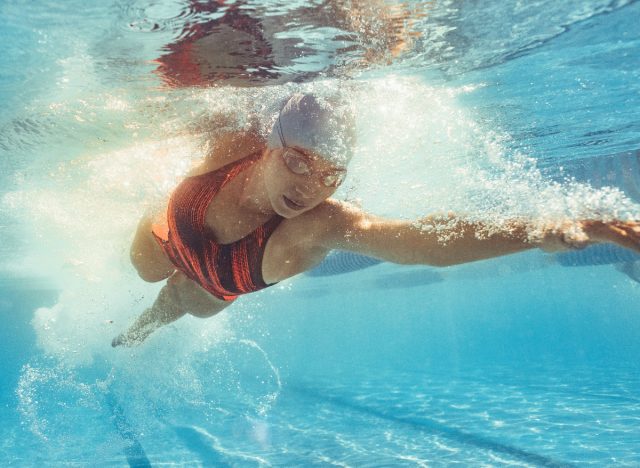Picture this: You’ve embarked on a weight-loss journey, determined to shed a few pounds and feel great. But with so many exercise options, you might be wondering, “Which workout will give me the best results?” Well, two all-around contenders often top the list: running and swimming. Both sports are fantastic ways to burn calories and sculpt your physique, offering a host of benefits. But which one reigns supreme when it comes to weight loss? Buckle up, because we’re about to take a deep dive (pun intended) into the world of running vs. swimming, breaking down the pros and cons of each to help you choose your perfect weight-loss partner.
Running and swimming are two of the most calorie-burning activities. Running gets your heart pumping and your legs working, while swimming works your entire body, from your core to your arms. These intense activities translate into a significant calorie burn, a key factor in weight loss. But beyond simply burning calories, both activities offer additional benefits that can support your weight-loss goals. Running strengthens your cardiovascular system, improves bone density, and improves your mood. Swimming, on the other hand, is a low-impact exercise that’s easy on your joints, making it ideal for those with injuries or joint pain. It also offers a refreshing escape from the summer heat.
So which one should you choose? Don’t worry, the answer isn’t simple. This article will cover critical factors, including calorie burn intensity, muscle engagement, and injury risk. We’ll also cover how to get the most out of each activity for weight loss and, most importantly, find an exercise you enjoy. In the end, I’ll give you the tools you need to choose the perfect weight loss workout, whether it’s pounding the pavement or gliding through the water, and most importantly, one that brings you joy.
Running or swimming: the ultimate fight for weight loss

So you’re on a mission to slim down and you’re wondering whether to lace up your running shoes or put on your swimsuit. As we’ve already said, both running and swimming are powerhouses when it comes to burning calories. With its high-intensity impact, running gets your heart pumping and your muscles working, burning away those stubborn fat stores. It’s a dynamic exercise that boosts your metabolism during the workout and keeps it elevated afterward, maximizing calorie burn throughout the day. On the other hand, swimming provides a full-body workout without stressing your joints, making it a soothing yet effective calorie burner.
Beyond the calorie burn, each activity provides unique weight-loss benefits. Running improves your cardiovascular health, strengthens your bones, and improves your mood, making it perfect for those looking to lose weight and improve their overall well-being. It’s a stress reliever and mood booster, providing mental clarity and a sense of accomplishment after each run. Meanwhile, the low-impact nature of swimming makes it a favorite among those recovering from injuries or looking for a joint-friendly exercise option. Plus, who can resist a refreshing splash on a hot day?
Factors to consider: calories burned, muscle engagement, and injury risk


When deciding whether to hit the track or dive into the pool, don’t just consider calorie burn. Running and swimming both target different muscle groups, from your legs to your core to your arms, albeit in different ways. While running primarily targets lower-body strength and endurance, swimming challenges your body to move efficiently through the water, sculpting muscles from head to toe. It’s a total-body workout that burns calories and improves muscle tone and definition.
When it comes to injury risk, the repetitive impact of running can strain joints and muscles, especially if proper technique and recovery aren’t prioritized. However, it also offers the potential to strengthen bones and connective tissue, reducing the risk of osteoporosis and other bone problems later in life. Conversely, the buoyant environment of swimming minimizes joint stress, making it an attractive choice for long-term fitness without the wear and tear associated with high-impact activities. By understanding these factors, you can make an informed choice that aligns with your weight loss goals and overall fitness journey.
Maximize Your Weight Loss: Tips and Tricks for Success


Whether you choose the rhythmic stride of running or the fluid movements of swimming, maximizing your weight-loss potential isn’t just about running on the pavement or in the pool. It’s about consistency, enjoyment, and efficiency. Here are some tips to help you get the most out of your workouts:
- Consistency is key: Stick to a regular training schedule to maintain your momentum and see consistent progress.
- Find Joy in the Journey: Choose activities you enjoy to make exercise an enjoyable habit rather than a chore.
- Adjust the intensity to your fitness level: Start at a comfortable pace and gradually increase the duration and intensity of your workouts to challenge your body and increase calorie burn.
- Incorporate interval training: Alternate between periods of high-intensity training and periods of low-intensity recovery to maximize calorie expenditure and improve cardiovascular fitness.
- Prioritize nutrition: Nourish your body with a balanced diet of nutrients to support your workouts and recovery.
- Stay hydrated: Drink plenty of water before, during and after workouts to keep your body functioning optimally.
- Mix: Combine running and swimming with other forms of exercise to keep your routine fresh and engaging.
- Set realistic goals: Set achievable goals to stay motivated and track your progress over time.
- Listen to your body: Pay attention to how your body feels and adjust your workouts to avoid injury and promote long-term health.
Jarrod Nobbe, MA, CSCS
Jarrod Nobbe is a USAW National Coach, Sports Performance Coach, Personal Trainer, and Writer. He has been involved in health and fitness for 12 years. Learn more about Jarrod
#Whats #Effective #Weight #Loss




